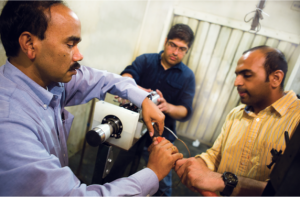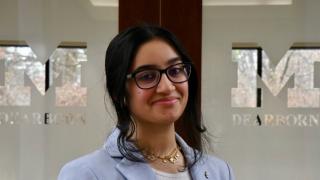 Pravansu Mohanty (left) assembles the laser-assisted cold spray Tssystem with assistance from graduate student Praneet Talwar and Ph.D. student Vikram Varadarrajan.
Pravansu Mohanty (left) assembles the laser-assisted cold spray Tssystem with assistance from graduate student Praneet Talwar and Ph.D. student Vikram Varadarrajan.
The technology Mohanty invented, known as “Laser-Assisted Cold Spray Process,” can help military personnel make more suitable repairs than those that are currently possible even in depot facilities.
“There are a lot of welding and/or cladding technologies currently available for component repairs, which generally work through some type of melting process,” Mohanty says. “Any time that process is performed, the repaired area becomes very different from the surrounding material—it’s usually inferior and doesn’t perform as well.”
Instead of welding or cladding, Mohanty’s system repairs damaged areas like cracks, bullet holes, and worn out parts in a solid state, but with a metallurgical bonding usually achieved in a melting process. The cold spray system couples a laser beam with a spray nozzle. Simultaneous laser irradiation of a fast-moving powder quickly fuses the damaged area to create a joint similar to its base level. The result is a more compatible repair that adds a protective layer for greater functionality.
“The entire repair process can be performed in the field using a hand-held apparatus,” said Mohanty, who has licensed the university-developed technology to CSquared Innovations, Inc., in which both the university and Mohanty are partners. “In addition, this process is an enabling technology in a variety of emerging applications. Several companies such as Ford Motor Company and Hyundai are exploring the laser-assisted cold spray process for different applications.”
Mohanty has collaborated with TARDEC on several projects since 2004. TARDEC has awarded over $5 million in contracts to Mohanty’s laboratory for several high-risk and high-payoff projects over the past 10 years. Another notable technology that was developed through past collaboration is the plasma/laser hybrid scheme, which is being deployed to manufacture spray-on lithium-ion batteries. Mohanty and three CECS graduate students are also researching next-generation battery manufacturing technologies.
“The college has a very collaborative research relationship with outside industry, including TARDEC,” Mohanty said.
Although Mohanty has worked with several federal agencies, including the Navy, the National Science Foundation, and the Department of Energy, the collaboration with TARDEC bears much greater practical significance. The close proximity to the campus is an added advantage.
“It’s important to understand the needs of partners like the military and automotive companies," he said. "We develop solutions to complex problems, as well as methods of commercializing the end product, to meet a need in the marketplace.”




